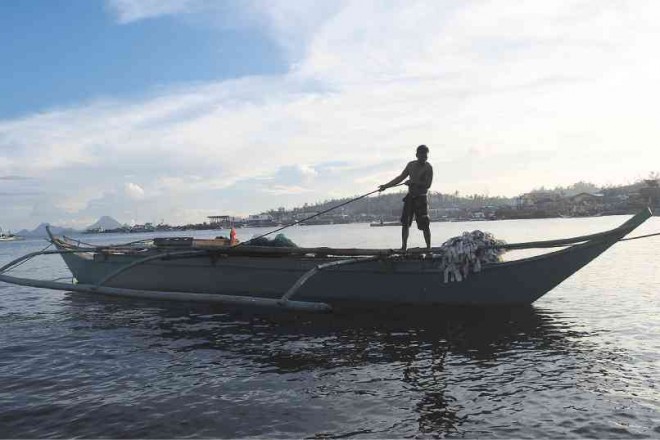Western Visayas: Opportunities emerge from rehab efforts

LIFE goes on for a fisherman in Estancia town, Iloilo province, who returns to fishing weeks after the town was ravaged by Supertyphoon “Yolanda.” NESTOR P. BURGOS JR./INQUIRER VISAYAS
ILOILO CITY—Communities in areas ravaged by Supertyphoon “Yolanda” in Western Visayas have started to pick up the pieces, but government planners, officials and business leaders are seeing difficulty in reaching full recovery.
On the other hand, the rehabilitation efforts also open opportunities for strategic, balanced and sustainable growth, according to business leaders.
The region’s economy, mostly reliant on agriculture and fisheries, needs massive capital infusion in terms of assistance to farmers and fishermen who lost boats and gear during the typhoon.
Agriculture and fisheries are expected to slow down due to the destruction of boats, crops, farm and fish implements and gears, and related infrastructure, said Raul Anlocotan, assistant regional director of the National Economic and Development Authority (Neda).
The Department of Agriculture estimated the damage to agriculture and fisheries at P7.48 billion, including crops, fish production, facilities and other structures, gear and equipment.
Article continues after this advertisementAbaca, coconut, vegetables and the rest of the industries could take at least three years to recover, said Roger Esto, Aklan economic and development officer. Damage to agriculture in Aklan province has reached P1 billion.
Article continues after this advertisementResettlement
Aklan also needs at least P565 million for housing and resettlement. The storm destroyed 32,346 houses and damaged 55,168.
Gov. Florencio Miraflores said residents along Aklan River and its coastline in Numancia town must be relocated. These areas are flood-prone and vulnerable to storm surges.
In areas hit hard in northern Iloilo province, officials are struggling to find relocation areas for coastal residents.
Mayor Arnold Betita of Carles town said about 7,000 people in the island-villages should be relocated to permanent sites, which have yet to be identified and acquired.
Those in the island-villages in Concepcion town have been directed to move their houses back from the shoreline. Alternative sites, however, had yet to be identified, said Mayor Millard Villanueva.
In Estancia town in Iloilo, about 100 families whose houses were destroyed in Barangay (village) Botongon are still living in tents in an evacuation center. Mayor Rene Cordero said the families were staying at Northern Iloilo Polytechnic State College.
(Under a new rule set by the government, areas 40 meters from the shoreline have been declared no-build zones, starting with places hit by Yolanda.)
Botongon was contaminated by an oil spill after a power barge slammed into its coastline, forcing the evacuation of 2,000 people due to high levels of toxicity in the air. Most of them returned to the village on Dec. 20 last year.
Cordero said the municipal government was considering a 2.2-hectare government property in Barangay Gogo as a permanent relocation site.
The recovery of the town could take at least a year and would depend on livelihood assistance to fishermen who lost their boats, he said.
Economic boosters
Construction activities, especially those funded by the government for the rebuilding and repair of structures, are expected to boost the economy. The cost of rebuilding in the worst hit areas may reach P12.7 billion, according to the Neda.
In Capiz province, business leaders said that while agriculture and fisheries in the province were badly hit, rehabilitation efforts would provide opportunities for implementing sustainable development projects, aside from jobs. These include flood control projects, infrastructure support to agriculture, clearing up of rivers and preservation of mangroves, and fish and marine sanctuaries to ensure fishery sustainability.
The Joint Chambers of Commerce-Capiz (JCCC) said in a statement that increased remittances from overseas Filipino workers to their families had cushioned the impact of the typhoon. JCCC is composed of the Capiz Micro, Small and Medium Enterprise Development Council (CMSMEDC), Roxas City Filipino Chinese Chamber of Commerce and Industry, Philippine Chamber of Commerce and Industry-Capiz, and Capiz Travel and Tour Operators Association.
Danilo So Chan, CMSMEDC chair, said farmers, fisherfolk, fishpond operators and poultry owners would need low interest loans to recover from the devastation.
The business groups said provinces in northern Panay should jointly plan priority rehabilitation projects that would upgrade infrastructure support facilities to improve logistics and enhance tourism prospects.
Northern Panay has tourist attractions, including Boracay Island in Aklan, and the seafood resources of Capiz. The pristine islands of northern Iloilo are also attracting more tourists, according to JCCC.